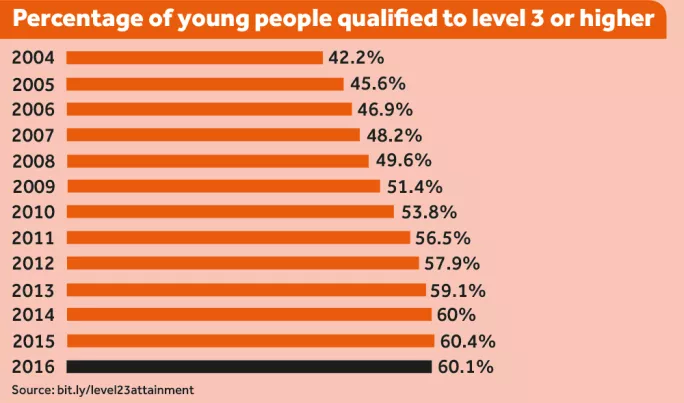Drop in attainment: serious shift or marginal statistic?

The proportion of young people who achieve a specific level of qualification is one of the most straightforward ways of measuring the success of an education system.
For more than a decade, the situation in England has steadily improved. The proportion of 19-year-olds earning both level 2 and level 3 qualifications has continued to rise, year on year, since 2004.
While the DfE insists that the changes are “marginal”, the fact that the numbers have dropped for the first time in more than a decade marks a significant shift
But new figures quietly published by the Department for Education reveal that, in 2016, 11 years of solid improvement ended. The proportion of 19-year-olds achieving a level 2 qualification (such as a GCSE C grade) fell to 86.7 per cent, from 87.5 per cent in 2015. And at level 3 (equivalent to A and AS level), the proportion fell from 60.4 per cent to 60.1 per cent.
While the DfE insists that the changes are “marginal”, the fact that the numbers have dropped for the first time in more than a decade marks a significant shift.

The changes at level 2 and 3 have been attributed to wholesale changes in qualifications - specifically, the move to decouple AS levels from A levels, as well as a drop in the number of young people taking advanced apprenticeships at level 3. And the shift at level 2 has been attributed to the adjustment in how vocational qualifications counted in school performance tables in 2013-14, resulting from the Wolf Report.
A DfE spokesperson says: “We are reforming education so that qualifications now meet tough new standards and enable progression into further study or employment, encouraging schools and colleges to teach these over low quality qualifications. In the context of these more rigorous new standards, we have seen a marginal drop in attainment at level 2 and 3 at age 19, although attainment remains significantly higher than in 2010.”
‘Increased risk aversion’
Last month, Ian Pryce, principal of Bedford College, argued that colleges were putting students forward for lower-level study in fear of their failure dragging down overall college achievement rates.
In response to the latest figures, he says: “The influx of low-level students who previously dropped out may have increased the risk aversion of colleges.”
In terms of the decoupling of AS levels, research by Ucas sheds some light on the impact of the changes. In December 2015, 59 per cent of schools surveyed said they planned to offer AS levels in all subjects; by March 2017, the figure dropped to 29 per cent.
In the same period, the proportion of schools no longer offering the AS at all increased from 21 per cent, in 2015, to 36 per cent this year.

“The picture that emerges from this survey shows that more schools and colleges are taking the opportunity to review their provision to focus on a programme of three linear A levels - although a majority still plan to offer AS qualifications in some subjects,” says Mary Curnock Cook, chief executive of Ucas.
Dave Thomson, a statistician at Education Datalab, believes the downturn in the percentage of pupils achieving level 2 or higher by the age of 19 can “largely be explained by changes in the types of qualification achieved by young people at the end of key stage 4”.
The drop, Baroness Wolf says, can be attributed to “statistical noise”
The data “does not appear to include qualifications equivalent to a GCSE but that can be delivered in under 325 guided learning hours,” he says. “In the years up to 2012-13 there was a large increase in these qualifications. So there seems to be a sizeable group of young people who have achieved level 2 but who have not been included in [these figures].”
Thomson expects that the figures for 2017 will record another drop in level 2 attainment. “The 2011 Wolf Report led to further change in the types of qualifications offered by schools and this began to affect the KS4 data from 2014 onwards. So we’re not really comparing like with like from year to year.”
The author of this seminal report, Baroness Wolf, sees no cause for concern in the figures. The drop, she says, can be attributed to “statistical noise”. And the Sir Roy Griffiths professor of public sector management at King’s College London, regards the most striking element of the latest figures as “how stable everything seemed to be”.
You need a Tes subscription to read this article
Subscribe now to read this article and get other subscriber-only content:
- Unlimited access to all Tes magazine content
- Exclusive subscriber-only stories
- Award-winning email newsletters
Already a subscriber? Log in
You need a subscription to read this article
Subscribe now to read this article and get other subscriber-only content, including:
- Unlimited access to all Tes magazine content
- Exclusive subscriber-only stories
- Award-winning email newsletters